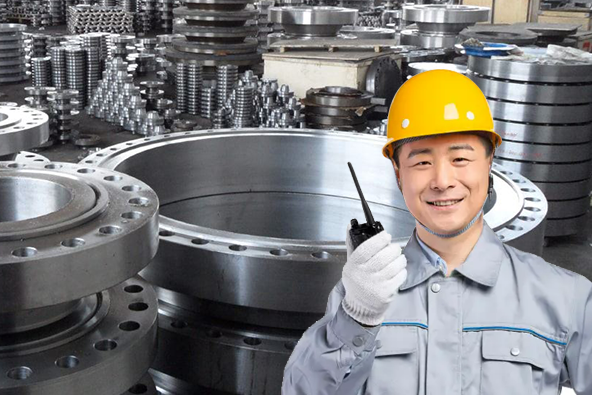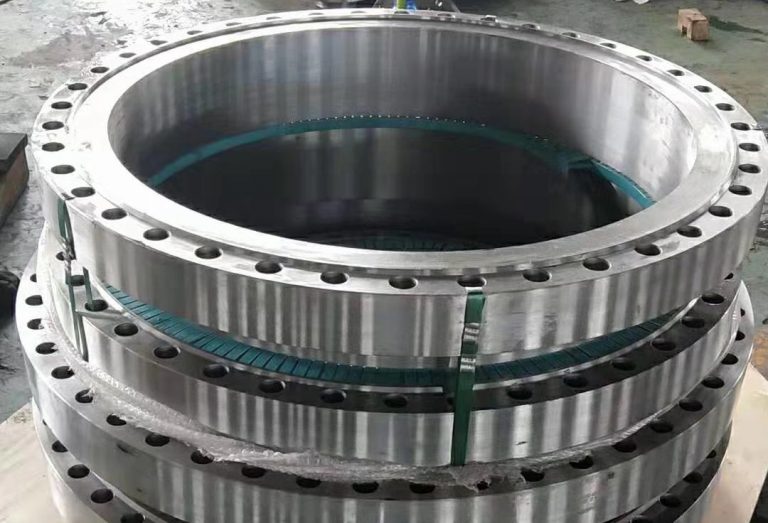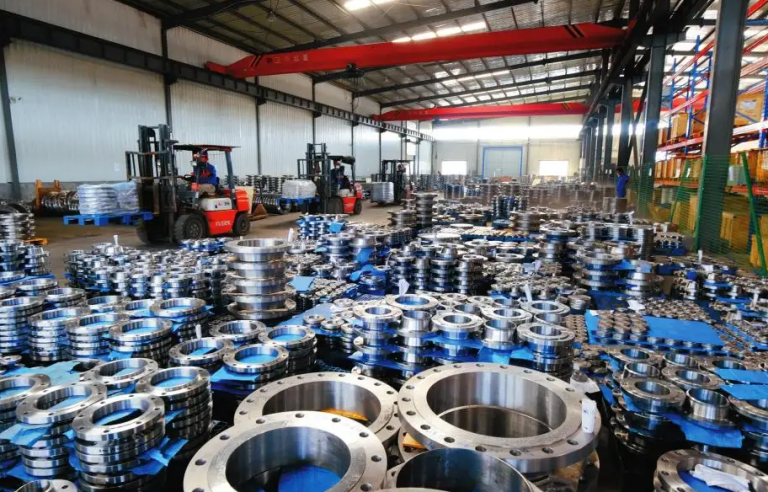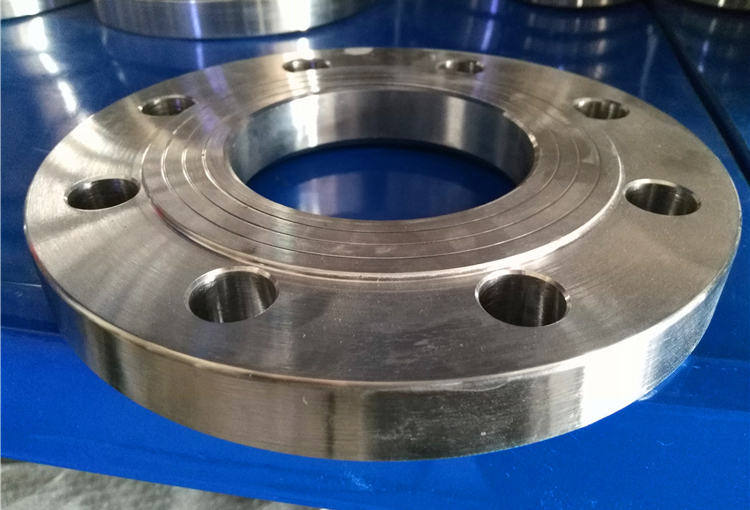Flanges are flat, circular components with evenly spaced holes used to connect pipes, valves, pumps, and other equipment in various industrial and engineering applications. They offer several advantages:
Easy Assembly and Disassembly
Easy assembly and disassembly is one of the key advantages of using flanges in various industrial applications. Here’s a more detailed explanation of this advantage:
- Quick Installation: Flanges simplify the process of connecting components, such as pipes, valves, and equipment. They feature bolt holes that align with corresponding holes on the mating flange, allowing for straightforward alignment and attachment. This ease of installation is particularly valuable in situations where speed and efficiency are essential, such as during initial system setup or equipment replacement.
- Reduced Downtime: When maintenance or repairs are required, flanges allow for swift disassembly of components without the need for cutting, welding, or extensive tooling. This minimizes downtime, as workers can easily disconnect and reassemble the system, thereby reducing the interruption to operations and production.
- Modularity: The modular nature of flange connections makes it simple to replace or upgrade individual components. For instance, if a valve or pump needs to be replaced, it can be disconnected from the system by undoing the bolts, and a new one can be installed in its place without major disruptions.
- Cost Savings: Flange-based systems are often more cost-effective when it comes to maintenance and repairs. Welding, on the other hand, can be expensive and time-consuming. With flanges, you can reuse existing components and avoid the need for specialized welding equipment and skilled welders.
- Adaptability: Flanges allow for the adaptation of systems to changing needs. You can add or remove components easily, modify the layout, or make adjustments as required without significant construction work or structural changes.
- Safety: The simplicity of assembly and disassembly with flanges can enhance safety. Workers can carry out these operations more efficiently and with reduced exposure to potentially hazardous conditions, which is especially important in industries with stringent safety requirements.
In summary, easy assembly and disassembly provided by flanges are advantageous for industries and applications that prioritize efficiency, maintenance, cost savings, and adaptability. They enable the rapid and hassle-free connection and disconnection of components, reducing downtime and facilitating system modifications or repairs.
Versatility
Versatility is a significant advantage of flanges in various industrial and engineering applications. Here’s a closer look at how flanges offer versatility:
- Material Compatibility: Flanges are available in a wide range of materials to suit different environmental conditions and the nature of the substances being transported. Common materials include carbon steel, stainless steel, alloy steel, brass, and various plastics. This material flexibility allows you to choose the right flange for your specific application, whether it involves corrosive chemicals, high temperatures, or food-grade materials.
- Size and Dimension Variability: Flanges come in various sizes and dimensions, making them adaptable to a wide range of pipe and equipment sizes. This versatility means you can use flanges in small or large-scale projects, from small-diameter pipes to large industrial pipelines, ensuring a consistent and reliable connection regardless of the scale.
- Flange Types: There are different types of flanges available, each designed for specific purposes. Common flange types include slip-on flanges, weld neck flanges, socket weld flanges, lap joint flanges, and blind flanges, among others. The choice of flange type allows you to meet the particular requirements of your project. For instance, weld neck flanges provide enhanced structural support, while blind flanges are used to seal off the end of a pipeline.
- Pressure and Temperature Range: Flanges are engineered to handle a wide range of pressure and temperature conditions. You can select flanges with appropriate pressure and temperature ratings to ensure the safety and reliability of your system, whether it operates at high or low pressures and temperatures.
- Compatibility with Various Components: Flanges are not limited to connecting pipes only. They can be used to connect various components, such as valves, pumps, and other equipment. This versatility allows you to build complex systems with multiple connections, all using flanges.
- Standardization: Flanges often adhere to industry standards and specifications, ensuring interchangeability and compatibility with components from different manufacturers. This standardization enhances flexibility when it comes to sourcing replacement parts and maintaining equipment.
- Adaptation to Different Industries: Flanges find applications in a wide range of industries, including oil and gas, petrochemical, food and beverage, pharmaceuticals, water treatment, and more. Their versatility makes them suitable for diverse environments and sectors, adapting to specific industry standards and requirements.
In summary, the versatility of flanges stems from their adaptability to different materials, sizes, pressure and temperature ranges, and various components. This adaptability allows engineers and professionals to use flanges in a wide array of applications while meeting specific project needs and industry standards.
Pressure Resistance
Pressure resistance is one of the key advantages of using flanges in industrial and engineering applications. Flanges are designed to withstand and contain high-pressure environments, which is essential in various systems and processes. Here’s how flanges offer pressure resistance:
- Secure Sealing: Flanges provide a reliable and leak-tight connection between components such as pipes, valves, and equipment. The gasket or sealing material placed between the flange faces forms a tight seal, preventing the escape of pressurized fluids or gases. This sealing mechanism is crucial in maintaining the integrity of the system under high pressure.
- Stress Distribution: Flanges help distribute the stress created by the pressure evenly across the joint, reducing the risk of localized stress concentrations that can lead to leaks or structural failures. This even distribution of stress is particularly important in applications with high-pressure variations.
- Material Selection: Flanges can be made from a variety of materials, including materials specifically chosen for their ability to withstand high pressures. Materials such as stainless steel and alloy steel are commonly used in applications where pressure resistance is a primary concern due to their strength and corrosion resistance properties.
- Pressure Rating: Flanges are available with different pressure ratings, which are specifications that indicate the maximum pressure they can safely withstand. These pressure ratings are typically based on standards and regulations, and you can select flanges with the appropriate pressure rating to match the requirements of your system.
- Reinforcement: In certain high-pressure applications, flanges can be reinforced with additional components such as gussets or stiffening rings to enhance their strength and pressure resistance.
- Safety: The pressure resistance of flanges plays a crucial role in ensuring the safety of industrial processes. They help prevent leaks, blowouts, and other potential hazards that could occur if the system were unable to contain the pressure.
- Reliability: Flanges provide a long-lasting and reliable solution for high-pressure systems. Properly designed and maintained flange connections can operate under high pressure for extended periods with minimal risk of failure.
In summary, the pressure resistance of flanges is vital in industries where maintaining the integrity of systems under high pressure is essential. Flanges offer a secure and leak-tight connection, distribute stress effectively, and come in various materials and pressure ratings to meet specific requirements, making them an important component in systems that handle pressurized fluids or gases.
Alignment
Flanges play a significant role in ensuring proper alignment of components in various industrial and engineering applications. Proper alignment is essential for system efficiency, functionality, and safety. Here’s how flanges help achieve alignment:
- Precise Fit: Flanges provide a precise and secure way to connect pipes, valves, and equipment. The alignment of flange faces and bolt holes ensures that the components are correctly positioned, creating a consistent and well-aligned connection.
- Elimination of Misalignment: Flanges help prevent misalignment issues that can occur with alternative connection methods, such as welding. Misalignment can result in stress concentrations, leaks, and operational inefficiencies. Flanges reduce the risk of these problems by ensuring components are aligned as intended.
- Tight Tolerances: Flanges are manufactured to tight tolerances, which means that the dimensions of the flange faces and bolt hole patterns are carefully controlled. This precision allows for a snug fit between the flanges, promoting accurate alignment.
- Stress Distribution: Flanges distribute stress evenly across the joint, preventing localized stress concentrations that could lead to misalignment or structural issues. This even distribution of stress is particularly important in high-pressure systems.
- Adaptability: Flanges can be adapted to accommodate various system configurations, ensuring that components are correctly aligned even in complex systems. Different types of flanges, such as weld neck, slip-on, or lap joint flanges, can be selected to suit specific alignment requirements.
- Alignment Aids: In some cases, alignment aids such as alignment pins or guide bars can be used in conjunction with flanges to ensure proper alignment during installation. These aids help prevent components from becoming misaligned during the assembly process.
- Reduced Maintenance: Proper alignment facilitated by flanges reduces wear and tear on components, leading to longer service life and reduced maintenance needs. Misaligned components can experience increased stress and premature failure.
- Safety: Alignment is essential for the safety of industrial systems. Proper alignment minimizes the risk of unexpected failures or leaks, which can lead to accidents or environmental damage.
In summary, flanges are crucial for achieving and maintaining proper alignment in industrial systems. They ensure a precise fit between components, prevent misalignment issues, and distribute stress evenly, contributing to system efficiency and safety. Proper alignment helps systems operate as intended, reduces maintenance requirements, and extends the lifespan of components.
Ease of Inspection
The ease of inspection is an important advantage of using flanges in various industrial and engineering applications. Inspecting flanges and the connections they create can help identify potential issues and ensure the continued safe and efficient operation of systems. Here’s how flanges facilitate easy inspection:
- Accessibility: Flanges provide access to the joint or connection point between components, such as pipes, valves, and equipment. This accessibility allows inspectors to visually examine the flange faces and the condition of the gasket or sealing material, which are critical for maintaining a leak-tight seal.
- Bolted Connection: Flanges are held together with bolts, making it relatively simple to remove and disassemble the connection for inspection. This is in contrast to welded connections, which may require cutting or grinding to access the joint.
- Visual Inspection: Inspectors can visually assess the condition of the flange faces, gaskets, and bolts. Signs of wear, corrosion, or damage can be readily identified during a visual inspection. This early detection is vital for preventing leaks and system failures.
- Non-Destructive Testing (NDT): In addition to visual inspection, non-destructive testing techniques, such as ultrasonic testing or dye penetrant testing, can be used to assess the integrity of the flange and its welds, if applicable. These techniques can detect hidden defects that may not be visible during a visual inspection.
- Gasket Replacement: If the inspection reveals that the gasket is damaged or worn, it can be replaced easily without the need for extensive disassembly. This helps maintain the leak-tight seal and extends the service life of the flange connection.
- Maintenance and Repairs: Easy inspection and disassembly of flange connections facilitate maintenance and repair activities. When a component or gasket needs to be replaced or maintenance is required, the system can be quickly and efficiently disassembled and reassembled.
- Documentation: The accessibility of flange connections makes it easier to document and record inspection findings, ensuring that maintenance and safety records are up to date and compliance with industry standards is maintained.
- Enhanced Safety: Routine inspection and maintenance of flanges contribute to the safety of industrial systems. Identifying potential issues early allows for timely corrective action, reducing the risk of accidents, leaks, and system failures.
In summary, flanges’ ease of inspection simplifies the process of assessing the condition of the connection points in industrial systems. Regular inspection of flanges helps maintain system integrity, extend the service life of components, and enhance safety. Inspectors can quickly identify and address any issues, preventing potential failures and minimizing downtime.
Reduced Welding
Reduced welding is another significant advantage of using flanges in various industrial and engineering applications. Here’s how flanges help reduce the need for welding and its associated challenges:
- Elimination of Welding for Connection: Flanges provide a bolted or clamped connection method that eliminates the need for welding to join pipes, valves, or equipment. This is particularly advantageous in situations where welding may be challenging or impractical, such as in areas with limited access, confined spaces, or where hot work permits are required.
- Simplified Installation: Flanges simplify the installation process, as they do not require the use of welding equipment, skilled welders, or the time-consuming process of preparing and welding joints. This results in quicker assembly and commissioning of systems.
- Reduced Heat-Affected Zones: Welding creates heat-affected zones (HAZ) in the materials being joined, which can alter their properties, potentially leading to stress corrosion cracking, brittleness, or other issues. Flanges eliminate the need for welding, thereby avoiding the creation of HAZ and preserving the material’s integrity.
- No Weld-Related Defects: Welding processes can introduce defects, such as porosity, cracks, or incomplete fusion, which may compromise the strength and integrity of the joint. Flange connections are less susceptible to these types of defects, resulting in more reliable and consistent connections.
- Ease of Maintenance: Flanges allow for easy disassembly and reassembly during maintenance or repairs without the need for welding. This simplifies the replacement of components, gaskets, or inspection of the connection, reducing downtime and maintenance costs.
- Flexibility in Component Replacement: In systems that use flanges, individual components (e.g., valves, pumps, or pipe sections) can be replaced without affecting the rest of the system. This is particularly useful when equipment needs to be upgraded or replaced with minimal disruption to ongoing operations.
- Cost Savings: The elimination of welding-related expenses, such as labor, welding equipment, and consumables, can result in cost savings. Flanges are often a more cost-effective option for creating connections in many applications.
- Reduced Safety Risks: Welding involves various safety risks, including exposure to high temperatures, hazardous fumes, and the potential for fires or explosions. Flanges can mitigate these risks, as they do not require welding operations in potentially hazardous environments.
- Avoidance of Welding Codes and Standards: Welding typically requires adherence to specific welding codes and standards, which can be complex and time-consuming. Flange connections, when designed and installed correctly, may simplify compliance with industry standards.
In summary, flanges offer the advantage of reduced welding, which simplifies installation, maintenance, and repairs, reduces the potential for defects and heat-affected zones, and results in cost savings. This is particularly valuable in applications where welding is not the most practical or efficient method for creating connections.
Cost-Effective
Flanges offer several cost-effective advantages in various industrial and engineering applications:
- Reduced Labor Costs: Flange connections are typically quicker and easier to install and maintain than welding. This reduces the labor costs associated with skilled welders and the time required for welding operations.
- Simplified Installation: Flanges allow for faster and more straightforward installation, as they do not require the extensive preparation and welding involved in traditional welding methods. This efficiency can lead to overall cost savings during project implementation.
- Ease of Maintenance: Flange connections simplify maintenance and repairs, reducing downtime and associated costs. Components can be easily disconnected and reassembled without the need for welding or specialized welding equipment.
- Versatility: Flanges are available in various sizes, materials, and types to suit different applications and budgets. Their versatility means you can select flanges that are cost-effective for your specific needs while maintaining reliability.
- Material Savings: The elimination of welding, which can result in the waste of excess materials and the creation of weld-related defects, can lead to material cost savings. Flanges create efficient, precision connections without the need for additional materials.
- Reduced Welding Equipment Costs: Welding equipment can be expensive to purchase and maintain. Flanges eliminate the need for costly welding equipment, which can contribute to significant savings over time.
- Avoidance of Welding Consumables: Welding requires consumables such as welding rods, gases, and other materials, which can be costly. Flange connections eliminate the need for these consumables.
- Interchangeability: Flanges are often standardized, making it easier to source replacement parts from various manufacturers. This interchangeability can reduce the costs associated with sourcing spare parts.
- Safety and Risk Mitigation: Flanges can contribute to cost savings by reducing the risk of accidents, injuries, and environmental damage. By avoiding welding in potentially hazardous environments, you can minimize the potential costs of safety incidents.
- Extended Service Life: Properly maintained flange connections can extend the service life of components and systems. This longevity can reduce the frequency of replacements and repairs, leading to cost savings over the long term.
- Compliance with Standards: Flanges often simplify compliance with industry standards, as they provide a standardized, well-documented method for creating connections. Meeting these standards can be more cost-effective than navigating complex welding codes and standards.
In summary, the cost-effective advantages of flanges are attributed to their ease of installation, maintenance, and versatility, which reduce labor and material costs. Flanges also help minimize the costs associated with welding equipment, consumables, and safety risks while extending the service life of components and facilitating compliance with industry standards.
Interchangeability
Interchangeability is a valuable advantage of using flanges in various industrial and engineering applications. Flanges are often standardized, which means that flange connections can be easily replaced or upgraded with components from different manufacturers. Here’s how interchangeability with flanges is advantageous:
- Compatibility: Flanges follow industry standards and specifications, ensuring compatibility between different components from various manufacturers. This means that a flange from one manufacturer can be used with a matching flange from another manufacturer, as long as they conform to the same standards.
- Reduced Downtime: In the event of component failure or the need for replacement, having interchangeable flanges allows for quicker and more convenient repairs. You can source replacement parts without extensive lead times or custom fabrication, minimizing system downtime.
- Cost Savings: Interchangeability can lead to cost savings by enabling you to choose components based on factors like price, availability, or specific project requirements. You’re not limited to a single supplier or brand, which can result in more competitive pricing.
- Flexibility: Interchangeable flanges offer flexibility in system design and modification. You can adapt or upgrade your system as needed, incorporating components that best suit your current requirements while maintaining compatibility with existing equipment.
- Availability of Spare Parts: Interchangeable flanges make it easier to source spare parts. This is particularly important for critical systems where downtime must be minimized. You can keep a stock of standard flanges or quickly obtain replacements in emergencies.
- Ease of Maintenance: When maintenance or repairs are necessary, the availability of interchangeable flanges simplifies the process. It reduces the time and effort required to locate suitable replacement components, streamlining maintenance operations.
- Standardization: Standardized flanges are well-documented and widely recognized. This standardization ensures that your system’s connections are in compliance with established industry standards and codes, enhancing safety and reliability.
- Reduction of Customization: Customizing components can be expensive and time-consuming. Interchangeable flanges minimize the need for customization, as you can typically find standard flanges that meet your project requirements.
- Upgrades and Retrofits: When upgrading or retrofitting systems, interchangeable flanges allow you to integrate new components into existing setups more easily. This is particularly valuable in industries where older systems need modernization.
- Consistency in Design: The use of interchangeable flanges promotes consistency in system design. This standardization simplifies engineering and construction processes, reducing the risk of errors and ensuring consistent quality.
In summary, interchangeability with flanges provides flexibility, cost savings, and convenience in terms of system design, maintenance, and repair. It allows you to select components based on your specific needs and easily source replacement parts, reducing downtime and ensuring compatibility with industry standards.
Reduced Risk of Contamination
Reduced risk of contamination is an important advantage of using flanges, particularly in industries where product purity and system integrity are critical, such as food processing, pharmaceuticals, chemicals, and water treatment. Here’s how flanges contribute to minimizing the risk of contamination:
- No Welding: Flanges eliminate the need for welding, which can introduce impurities into the system. Welding processes may generate weld spatter, slag, or other contaminants that can contaminate the fluids or substances being transported. Flange connections avoid these potential sources of contamination.
- Clean Interface: Flange connections provide a clean and smooth interface between components, such as pipes, valves, or equipment. This reduces the likelihood of particles, debris, or residues getting trapped in the connection and subsequently contaminating the product.
- Sealing Mechanism: Flange connections use gaskets or sealing materials to create a tight seal between components. These gaskets are selected based on compatibility with the fluid or substance being transported. This choice ensures that the seal remains leak-tight and prevents the entry of contaminants into the system.
- Sanitary Flanges: In industries where hygiene is of utmost importance, such as the food and pharmaceutical sectors, sanitary flanges are often used. These flanges are designed to have smooth, crevice-free surfaces, reducing the risk of bacterial growth and making them easier to clean and maintain.
- Material Compatibility: Flanges are available in various materials, allowing you to select materials that are compatible with the substances being transported. This minimizes the risk of material degradation or leaching, which could lead to contamination.
- Easy Inspection and Maintenance: Flanges’ accessibility and ease of inspection allow for regular checks to ensure there are no signs of wear, damage, or contamination. Any issues can be addressed promptly through maintenance or component replacement.
- Certification and Compliance: Flanges used in industries with strict regulatory requirements often meet specific industry standards and certifications, ensuring that the components are designed to minimize the risk of contamination.
- Traceability: Interchangeable flanges, which are often standardized, can enhance traceability of components and materials used in the system. This traceability can be valuable for quality control and identifying potential sources of contamination.
- Reduction of Cross-Contamination: Flanges allow for the isolation of different sections of a pipeline or system. This can prevent cross-contamination between different substances or products, ensuring the integrity of each.
In summary, flanges contribute to reduced risk of contamination by providing clean and secure connections, minimizing the introduction of impurities, and allowing for regular inspection and maintenance. These characteristics make flanges especially beneficial in industries where product purity and system cleanliness are paramount.
Isolation of Components
The isolation of components is an advantage of using flanges in industrial and engineering applications. Flanges allow you to separate or isolate specific sections of a pipeline or system without affecting the rest of the system. Here’s how flanges facilitate component isolation:
- Closure with Blind Flanges: Blind flanges are specifically designed to seal off the end of a pipeline or a connection point. By using blind flanges, you can isolate a section of the system. This is useful when you need to temporarily close off a pipe or valve for maintenance, repairs, or system modifications.
- Versatility in Isolation: Flanges provide a versatile method of isolation, allowing you to choose the appropriate type of flange for your isolation needs. You can use slip-on, weld neck, lap joint, or socket weld flanges, depending on the specific requirements of your application.
- Reduced Downtime: Isolating components with flanges minimizes downtime during maintenance or repair activities. When a section of the system needs work, you can quickly disconnect and isolate it using flanges while the rest of the system continues to operate.
- Ease of Inspection: Isolation with flanges also simplifies the inspection process. You can isolate a component, remove it for inspection or maintenance, and then easily reconnect it with minimal disruption to the rest of the system.
- Prevention of Cross-Contamination: Isolating components with flanges helps prevent cross-contamination between different substances or products being transported in the system. This is crucial in industries like food processing, pharmaceuticals, and chemicals.
- Enhanced Safety: Flanges contribute to the safety of isolation procedures. They provide a secure and reliable method for closing off components, reducing the risk of accidents or unexpected releases when isolating sections of the system.
- Adaptability: Flanges offer adaptability for various isolation needs, whether it involves isolating a valve, pump, heat exchanger, or any other component. The choice of flange type can be tailored to the specific component and the required isolation.
- Reduced Environmental Impact: Flanges help prevent leaks and spills when isolating components, reducing the potential environmental impact of the system. This is particularly important in applications where the transported substances are hazardous or environmentally sensitive.
In summary, the isolation of components using flanges is a practical and effective way to manage and maintain industrial systems. Flanges offer versatility, ease of maintenance, and safety, making them a valuable component in industries where isolation is required for maintenance, safety, and process control.
It’s important to note that the choice of flange type and material should be based on the specific requirements of your application, including factors such as pressure, temperature, and the type of fluid being transported. Proper installation and maintenance of flanges are also essential to ensure their effectiveness and reliability.
Lewis Liu
Hello, I am Lewis Liu, a professional sales engineer with over ten years of experience in the flange fittings industry. I am highly knowledgeable in flange selection, installation, and maintenance. I am passionate about providing customers with the best solutions to ensure their pipeline systems run smoothly, safely, and reliably.
If you have any questions or concerns regarding flange fittings for your pipelines, whether it’s about selection, material choice, specification requirements, or any other aspect, please feel free to contact me at any time. I am committed to offering professional advice and assistance to help you make informed decisions and meet your needs.




